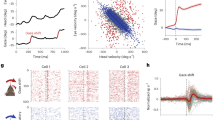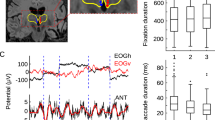Abstract
CONSPICUOUS visual features commonly attract gaze1,2, but how the brain selects targets for eye movements is not known. We investigated target selection in rhesus monkeys performing a visual search task3 by recording neurons in the frontal eye field, an area known to be responsible for generating purposive eye movements4,5. Neurons with combined visual- and eye movement-related activity were analysed. We found that the initial visual responses to search stimulus arrays were the same whether the target or a distractor was in the response field. We also found that the neural activity evolved to specify target location before the execution of eye movements, ultimately peaking when the target was in the response field and being suppressed when the target was beside but not distant from the response field. These results demonstrate a possible mechanism by which a desired target is fixated and inappropriate eye movements are prevented.
This is a preview of subscription content, access via your institution
Access options
Subscribe to this journal
Receive 51 print issues and online access
$199.00 per year
only $3.90 per issue
Buy this article
- Purchase on Springer Link
- Instant access to full article PDF
Prices may be subject to local taxes which are calculated during checkout
Similar content being viewed by others
References
Yarbus, A. L. Eye Movements and Vision (Plenum, New York, 1967).
Engel, F. Vision Res. 17, 95–108 (1977).
Treisman, A. Q. JI. exp. Psychol. 40A, 201–237 (1988).
Bruce, C. J. & Goldberg, M. E. J. Neurophysiol. 53, 603–635 (1985).
Schall, J. D. J. Neurophysiol. 66, 559–579 (1991).
Bruce, C. J., Goldberg, M. E., Bushnell, C. & Stanton, G. B. J. Neurophysiol. 54, 714–734 (1985).
Chelazzi, L., Miller, E. K., Duncan, J. & Desimone, R. Nature 363, 345–347 (1993).
Ottes, F. P., Van Gisbergen, J. A. M. & Eggermont, J. J. Expl Brain Res. 66, 465–478 (1987).
Glimcher, P. W. & Sparks, D. L. Nature 355, 542–545 (1992).
Leichnetz, G. R. & Goldberg, M. E. in Neuroanatomy of the Oculomotor System (ed. Büttner-Ennever, J. A.) 365–429 (Elsevier, New York, 1988).
Segraves, M. & Goldberg, M. E. J. Neurophysiol. 58, 1387–1419 (1987).
Segraves, M. A. J. Neurophysiol. 68, 1967–1985 (1992).
Allman, J., Miezen, F. & McGuinness, E. A. Rev. Neurosci. 8, 407–430 (1985).
Koch, C. & Ullman, S. Hum. Neurobiol. 4, 219–227 (1985).
Cave, K. R. & Wolfe, J. M. Cognitive Psychol. 22, 225–271 (1990).
Schall, J. D. J. Neurophysiol. 66, 530–558 (1991).
Author information
Authors and Affiliations
Rights and permissions
About this article
Cite this article
Schall, J., Hanes, D. Neural basis of saccade target selection in frontal eye field during visual search. Nature 366, 467–469 (1993). https://doi.org/10.1038/366467a0
Received:
Accepted:
Issue Date:
DOI: https://doi.org/10.1038/366467a0
This article is cited by
-
Neural evidence for attentional capture by salient distractors
Nature Human Behaviour (2024)
-
Modulation of Neuronal Activity and Saccades at Theta Rhythm During Visual Search in Non-human Primates
Neuroscience Bulletin (2022)
-
The lateral prefrontal cortex of primates encodes stimulus colors and their behavioral relevance during a match-to-sample task
Scientific Reports (2020)
-
Presaccadic attention improves or impairs performance by enhancing sensitivity to higher spatial frequencies
Scientific Reports (2019)
-
Human gaze tracks attentional focusing in memorized visual space
Nature Human Behaviour (2019)
Comments
By submitting a comment you agree to abide by our Terms and Community Guidelines. If you find something abusive or that does not comply with our terms or guidelines please flag it as inappropriate.



